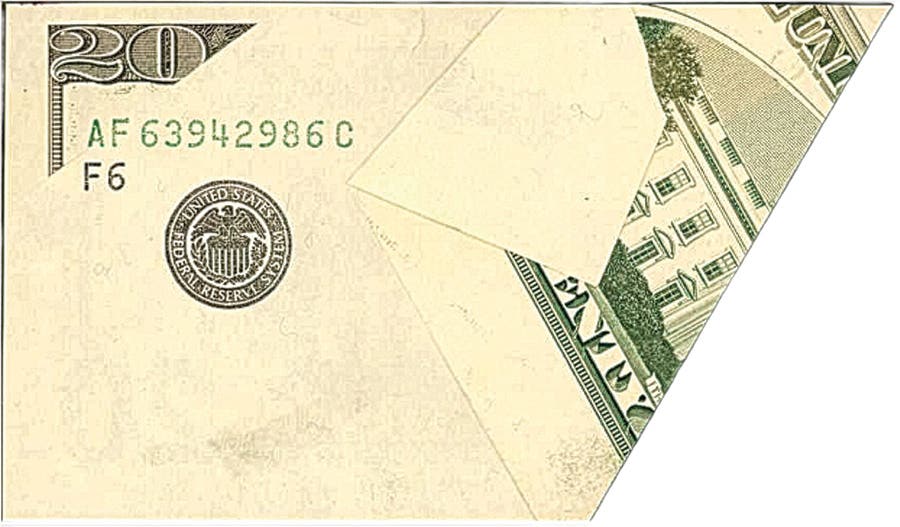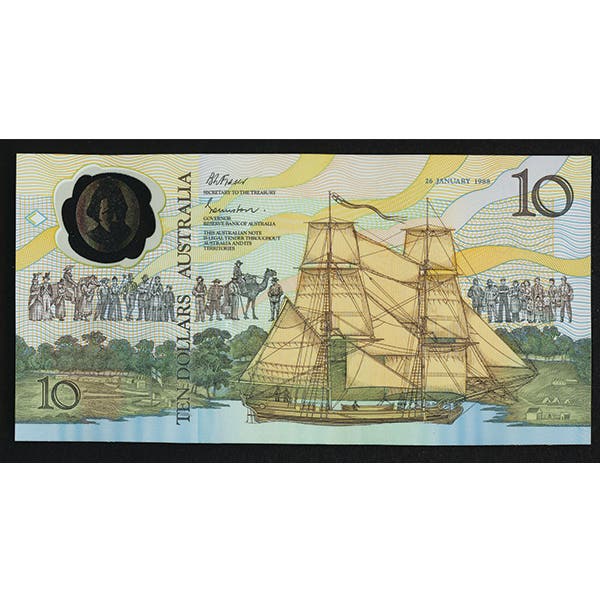College and University National Banks
Purpose Bankers often incorporated in their titles descriptors for things that they wished their business to be identified with such as geographic features or landmarks, industries, professional trades, etc. Similarly,…
Purpose
Bankers often incorporated in their titles descriptors for things that they wished their business to be identified with such as geographic features or landmarks, industries, professional trades, etc. Similarly, town names often carry or incorporate a defining feature of the community.
It is natural that some bank and town names honored institutions of higher learning. There were nine national bank titles in the country where the bank or town name incorporated the word college or university and that wording appeared on their notes.
It is the purpose of this article to present a pictorial essay consisting of one note or proof from each of these issuers along with pertinent tidbits that may be of interest. Proofs are illustrated only if there are no reported notes from the bank. This presentation is organized alphabetically by state and then numerically by charter number within the state.
The College National Bank of Berkeley, California. (11495)
Berkeley hosts the oldest campus of the University of California in the California university system. The university dates from 1868.
The College National Bank was chartered Oct. 31, 1919, and liquidated July 27, 1929, when it was absorbed by American Trust Company, San Francisco. From 1923 forward, The College National occupied its own building on the northwest corner of Shattuck Avenue and Addison Street immediately west of the campus in downtown Berkeley. The bankers maintained a $200,000 circulation between 1919 and 1925, but ceased issuing during 1926-1929. They consumed 20,458 sheets of 10-10-10-20 Series of 1902 blue seal plain backs to maintain their circulation during their note-issuing days.
The First National Bank of College Springs, Iowa (11295)
College Springs currently is a town of less than 200 people in the southwest corner of Iowa two miles above the Missouri line. It was given its name because it was home to a school called Amity College that operated between 1855 and 1913. The spring part refers to a nearby spring, reputed to have very clear water. The bank was organized by president W. S. Farquhar and cashier L. W. Farquhar, and chartered Jan. 31, 1919. O. J. Miller became cashier in 1926. The bank was absorbed by Citizens State Bank of Clarinda on Nov. 25, 1929.
The fascinating thing about the bank was that its officers maintained a token $1,000 circulation during its entire existence. They issued Series of 1902 blue seal plain backs printed from a 10-10-10-20 plate, meaning that at any one time their entire outstanding circulation was represented by only 20 sheets of notes. They consumed only 92 sheets (368 notes) during the life of the bank to maintain this tiny circulation. This was the second smallest number of large size notes issued by any bank in the state. Is it any wonder that none are reported?
First National Bank of University Place, Nebraska. (7737)
University Place is a neighborhood in Lincoln, Neb. Lincoln is the state capital as well as home to the University of Nebraska, However, University Place is named for Nebraska Wesleyan University, which occupies the center of the University Place neighborhood. The bank was chartered May 12, 1905, and went into receivership Dec. 29, 1926. It issued modest numbers of Series of 1902 red seals, blue seal date backs and blue seal plain backs from a 10-10-10-20 plate to support a circulation that stood at $40,000 in 1924. The bankers ceased issuing in 1925.
My first academic posting was at the University of Nebraska at Lincoln between 1970 and 1974, so I avidly searched for a note from the bank. They turned out to be quite scarce because it took until a March 15, 2002 Knight sale for me to land one. I paid $2,425 for the note illustrated here, which I thought was a ton.
College Point National Bank of New York, New York (13105)
College Point is a working-class neighborhood in the borough of Queens that lies west of the south approach to the Whitestone Bridge. The area was named College Point for St. Paul’s College, a seminary founded in 1835 by the Rev. William Augustus Muhlenberg. The college closed around 1850, but the name remained.
The bank was chartered July 19, 1927 and remained open to the end of the note-issuing era. The bankers issued only $5 and $10 Series of 1929 type 1 and 2 notes. Their circulation peaked at $200,000 in 1933.
The First National Bank of College Corner, Ohio (5277)
This is the oldest bank in this group, having been chartered April 7, 1900, when it succeeded Citizens Bank. It lasted only five years to July 1, 1905 whereupon it was liquidated. Its first president was Oscar Stout. J. H. McCray succeeded Oscar as president in 1904. Cashier Charles Stout served for the duration.
College Corner was settled in 1811 and takes its name from its position in the northwestern corner of what was called the College Township, a surveyed township designated the previous year by the Ohio General Assembly to become the site of the state college. That college became Miami University. The township was later organized as a civil township called Oxford Township. The town of Oxford is in the center of the township and it hosts the university. College Corner, with a current population of about 400, lies 5 miles to the northwest along U.S. 27.
The claim to fame for Miami University is that renowned dealer and national bank note census taker Don Kelly taught physics there during his career. Kelly has turned over every rock he could find to locate a note from College Corner to no avail. This makes sense because the bankers maintained a small $25,000 circulation during their short existence, consuming in the process 1,107 sheets of 10-10-10-20 Series of 1882 brown backs. The small circulation coupled with the short early life of the bank spells rarity.
The First National Bank of State College, Pennsylvania (7511)
State College in central Pennsylvania evolved from a village to a town to serve the needs of what became The Pennsylvania State University (Penn State) in 1953. The university traces its origin to the Farmers’ High School of Pennsylvania established in 1855. That school grew to become the Agricultural College of Pennsylvania in 1862. The college was designated by the state legislature as the state’s sole land-grant college in 1863 following passage of Federal legislation providing for land grant institutions. The college was renamed Pennsylvania State College in 1874.
The First National Bank of State College was chartered Dec. 14, 1904 and remained active beyond the end of the note-issuing era. Within three years, the officers built their circulation up to $50,000, a number that held to 1935. They issued everything from Series of 1902 red seals to 1929 type 2 notes in $5 through $20 denominations.
The Collegeville National Bank, Pennsylvania (8404)
Collegeville is a borough in Montgomery County, a suburb of Philadelphia, that was incorporated in 1896. However, the location was named Collegeville by the railroad in 1868 owing to the presence of the Pennsylvania Female College established by Abraham Hunsicker in 1851 near present day Glenwood Avenue there. Thus, the College in Collegeville originates with and refers to that 4-year liberal arts college, which closed in 1880. Ursinus College, a premier liberal arts college that is still operating, was established in Collegeville in 1869, so the town name precedes its establishment.
The Collegeville National Bank was chartered Oct. 17, 1906 and lasted beyond the end of the note issuing era. Thus, it issued $10 and $20 Series of 1902 red seals through Series of 1929 type 2 notes.
The Peoples National Bank of State College, Pennsylvania (12261)
Lee Lofthus, who enjoys finding notes with excellent eye appeal from interesting towns, inspired this article when he showed off the note illustrated here. He had seen it in a dealer’s case a few years ago, passed on it because he had another iron in the fire, realized that was a mistake only to return to discover it was gone. How many of us have made that mistake? To his delight, the same dealer repurchased the note and Lee snapped it up this time. Sometimes you get lucky. As soon as he showed it to me, it clicked that the college/university banks should be profiled.
The Peoples National Bank of State College was the second and last note-issuing bank in town being chartered on October 17, 1922. The officers in the bank built the circulation up to $50,000 by the end of the large-note era and increased it to $125,000 by the end of the small-note era. Included were $5s, $10s and $20s Series of 1902 blue seal plain backs and 1929 type 1 and 2 notes.
Notes from this bank are about twice as available as notes from The First National Bank of State College consistent with its larger circulation.
The University National Bank of Seattle, Washington (12153)
The University National Bank of Seattle had its origins as The University State Bank, which was incorporated in 1906. That bank was converted to The University National Bank on April 1, 1922, when it received its national charter. From 1912 forward it occupied a two-story building sheathed in gleaming white terra cotta tiles on the northeast corner of NE 45th Street and University Way NE. This location was immediately northwest of the University of Washington campus that its officers wanted to be identified with. The university was far older, having been established in 1861. The bank continues to serve the university and Seattle as a branch of Wells Fargo, although Wells Fargo sold the white building in 2018.
The bankers maintained a circulation of $200,000 during the large-note era, and grew it to $400,000 from 1932 through 1935. They issued $5, $10 and $20 Series of 1902 blue seal plain backs and 1929 type 1 and 2 notes. Notes from this bank are the most readily available of the banks profiled here.
Perspective
A topical collection such as the one treated here offers a challenging pursuit with the reward being notes from several states and series, thus yielding interesting variety. Along the way, there is a lot to be learned in terms of geography and history.
Sources
Historical information pertaining to towns, colleges and universities: Wikipedia
Photo credits:
Heritage Auction archives: 7511, 8404, 11495, 12153, 13105
Huntoon, Peter: 7737
Lofthus, Lee: 12261
National Numismatic Collection, BEP Proofs: 5277, 11295
https//hunterscapital.com/university-bank-building/: University National Bank of Seattle vault door.









